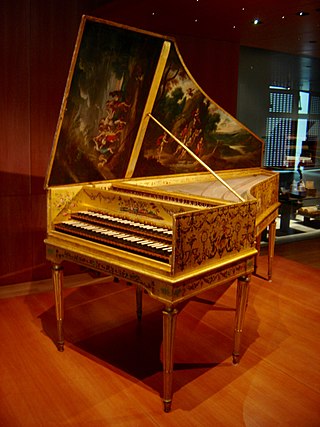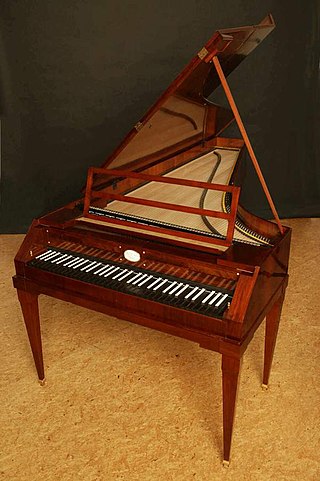
A harpsichord is a musical instrument played by means of a keyboard. This activates a row of levers that turn a trigger mechanism that plucks one or more strings with a small plectrum made from quill or plastic. The strings are under tension on a soundboard, which is mounted in a wooden case; the soundboard amplifies the vibrations from the strings so that the listeners can hear it. Like a pipe organ, a harpsichord may have more than one keyboard manual, and even a pedal board. Harpsichords may also have stop buttons which add or remove additional octaves. Some harpsichords may have a buff stop, which brings a strip of buff leather or other material in contact with the strings, muting their sound to simulate the sound of a plucked lute.

The piano is a stringed keyboard instrument in which the strings are struck by wooden hammers that are coated with a softer material. It is played using a keyboard, which is a row of keys that the performer presses down or strikes with the fingers and thumbs of both hands to cause the hammers to strike the strings. It was invented in Italy by Bartolomeo Cristofori around the year 1700.

Bartolomeo Cristofori di Francesco was an Italian maker of musical instruments famous for inventing the piano.

A fortepiano[ˌfɔrteˈpjaːno], sometimes referred to as a pianoforte, is an early piano. In principle, the word "fortepiano" can designate any piano dating from the invention of the instrument by Bartolomeo Cristofori in 1698 up to the early 19th century. Most typically, however, it is used to refer to the mid-18th to early-19th century instruments for which composers of the Classical era, especially Haydn, Mozart, and the younger Beethoven wrote their piano music. Starting in Beethoven's time, the fortepiano began a period of steady evolution, culminating in the late 19th century with the modern grand. The earlier fortepiano became obsolete and was absent from the musical scene for many decades. In the 20th century the fortepiano was revived, following the rise of interest in historically informed performance. Fortepianos are built for this purpose in specialist workshops.

The tangent piano is a very rare keyboard instrument that resembles a harpsichord and early pianos in design. It normally features five octaves of keys and the strings are acted upon by narrow wooden or metal slips when the keys are depressed.
Keyboard expression is the ability of a keyboard musical instrument to change tone or other qualities of the sound in response to velocity, pressure or other variations in how the performer depresses the keys of the musical keyboard. Expression types include:

Johann (Georg) Andreas Stein was an outstanding German maker of keyboard instruments, a central figure in the history of the piano. He was primarily responsible for the design of the so-called German hammer action. Pianos with this hammer action, or its more developed form known as the Viennese action, may be said to be appropriate for the performance of the piano music of Haydn, Mozart, and the early Beethoven.

John Broadwood was the Scottish founder of the piano manufacturer Broadwood and Sons.

Gottfried Silbermann was a German builder of keyboard instruments. He built harpsichords, clavichords, organs, and fortepianos; his modern reputation rests mainly on the latter two.
The modern form of the piano, which emerged in the late 19th century, is a very different instrument from the pianos for which earlier classical piano literature was originally composed. The modern piano has a heavy metal frame, thick strings made of top-grade steel, and a sturdy action with a substantial touch weight. These changes have created a piano with a powerful tone that carries well in large halls, and which produces notes with a very long sustain time. The contrast with earlier instruments, particularly those of the 18th century is very noticeable. These changes have given rise to interpretive questions and controversies about performing earlier literature on modern pianos, particularly since recent decades have seen the revival of historical instruments for concert use.
Johannes Zumpe was a leading maker of early English square pianos, a form of rectangular piano with a compass of about five octaves. The pianos sounded like mellow harpsichords, and had a damper stop in the left cheek of the case. Zumpe is known as the creator of English square pianos.

The soft pedal is one of the standard pedals on a piano, generally placed leftmost among the pedals. On a grand piano this pedal shifts the whole action slightly to the right, so that the hammers which normally strike all three of the strings for a note strike only two of them. This softens the note and also modifies its tone quality. Tone quality is also affected by forcing the remaining two strings being struck to make contact with a part of the hammer felt which is not often hit ; this results in a duller sound, as opposed to the bright sound which is usually produced.
The action of a string instrument that is plucked, strummed, or bowed by hand is the distance between the fingerboard and the string. In keyboard instruments, the action is the mechanism that translates the motion of the keys into the creation of sound.
The piano action mechanism of a piano or other musical keyboard is the mechanical assembly which translates the depression of the keys into rapid motion of a hammer, which creates sound by striking the strings. Action can refer to that of a piano or other musical keyboards, including the electronic or digital stage piano and synthesizer, on which some models have "weighted keys", which simulate the touch and feel of an acoustic piano. The design of the key action mechanism determines the "weighted keys" feeling; that is, the feeling of the heaviness of the touch of the keys."A professional pianist is likely to care most about the piano's action, because that is what controls its responsiveness and relative lightness--or heaviness--of touch. Roughly speaking, a piano's action is light when its keys fall easily under the fingers, and heavy when a noticeable downward thrust is required. The action, in short, is what makes a piano playable or not to an individual musician."

Sébastien Érard was a French instrument maker of German origin who specialised in the production of pianos and harps, developing the capacities of both instruments and pioneering the modern piano.

Piano pedals are foot-operated levers at the base of a piano that change the instrument's sound in various ways. Modern pianos usually have three pedals, from left to right, the soft pedal, the sostenuto pedal, and the sustaining pedal. Some pianos omit the sostenuto pedal, or have a middle pedal with a different purpose such as a muting function also known as silent piano.

Robert Wornum (1780–1852) was a piano maker working in London during the first half of the 19th century. He is best known for introducing small cottage and oblique uprights and an action considered to be the predecessor of the modern upright action which was used in Europe through the early 20th century. His piano manufacturing business eventually became Robert Wornum & Sons and continued half a century after his death.

Alfred James Hipkins FSA was an English musician, musicologist and musical antiquary.

Music technology is the study or the use of any device, mechanism, machine or tool by a musician or composer to make or perform music; to compose, notate, playback or record songs or pieces; or to analyze or edit music.

Mechanical music technology is the use of any device, mechanism, machine or tool by a musician or composer to make or perform music; to compose, notate, play back or record songs or pieces; or to analyze or edit music. The earliest known applications of technology to music was prehistoric peoples' use of a tool to hand-drill holes in bones to make simple flutes. Ancient Egyptians developed stringed instruments, such as harps, lyres and lutes, which required making thin strings and some type of peg system for adjusting the pitch of the strings. Ancient Egyptians also used wind instruments such as double clarinets and percussion instruments such as cymbals. In Ancient Greece, instruments included the double-reed aulos and the lyre. Numerous instruments are referred to in the Bible, including the horn, pipe, lyre, harp, and bagpipe. During Biblical times, the cornet, flute, horn, organ, pipe, and trumpet were also used. During the Middle Ages, hand-written music notation was developed to write down the notes of religious Plainchant melodies; this notation enabled the Catholic church to disseminate the same chant melodies across its entire empire.













